
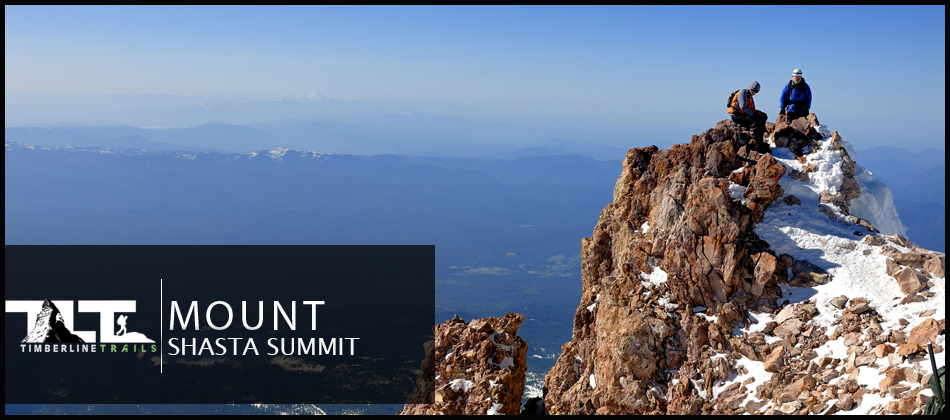 Mt Shasta's Summit in the winter and early spring season is a beautiful knife edge looking block of volcanic rock encrusted with snow and ice.
Mt Shasta's Summit in the winter and early spring season is a beautiful knife edge looking block of volcanic rock encrusted with snow and ice. To the approaching climber, a view like the one in the photo below looks a little intimidating at first, but the final slopes appear worse than they actually are. Even though most folks are pretty exhausted by the time they get to this point, the excitement of a looming summit is enough to put some of that so called "wind in your sails" type of feeling back into you. After crossing the above lower summit plateau, a short but still tiring 200 foot climb up snow and ice (in early season) or rock (in later season) awaits you.
If you look closely at the above image, you can see Mt Lassen in the far distant horizon (seventy three miles away). To the north, you can see clear into the State of Oregon and to the east you can see all the way to the State of Nevada.
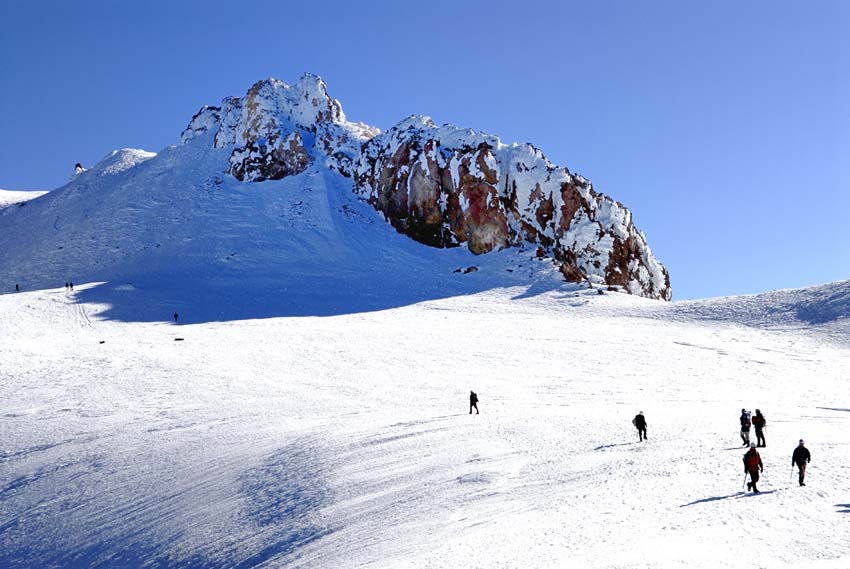 Once you attain the Summit of Mt Shasta, you are more than 5,000 feet above its tallest neighbor and more than 10,000 feet above its base elevation. You will also be able to peer down the northern slopes of this magnificent peak and see the beautiful glacial ice that cloaks that side of the peak. With a base diameter of more than 17 miles Mount Shasta has the greatest volume of all the Cascade Peaks.
Once you attain the Summit of Mt Shasta, you are more than 5,000 feet above its tallest neighbor and more than 10,000 feet above its base elevation. You will also be able to peer down the northern slopes of this magnificent peak and see the beautiful glacial ice that cloaks that side of the peak. With a base diameter of more than 17 miles Mount Shasta has the greatest volume of all the Cascade Peaks.In the photo above and below you can see climbers making their final push to the summit. Once you have gained the summit plateau (as seen in the image above), misery hill is behind you and the summit is only a short distance away. Even though it looks intimidating, the last slope that leads to the top is not that hard. And with a bit more effort you will be on the summit.
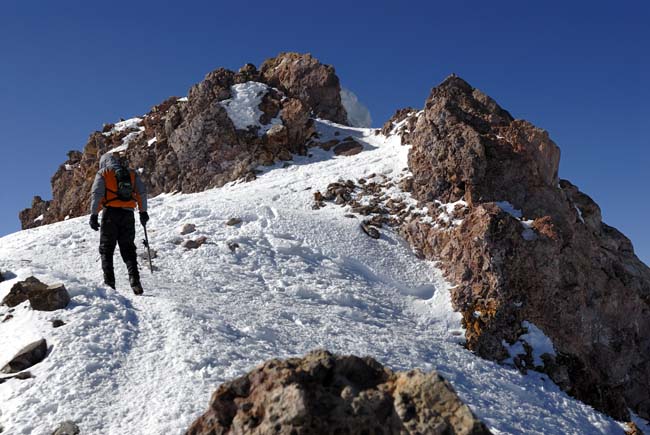 It is always a good feeling to conquer a challenging mountain peak, and Mt Shasta has a lot to offer climbers of all skill levels. Being on top of a 14,000 foot peak like Mt Shasta has many wonderful rewards all its own.
It is always a good feeling to conquer a challenging mountain peak, and Mt Shasta has a lot to offer climbers of all skill levels. Being on top of a 14,000 foot peak like Mt Shasta has many wonderful rewards all its own.Views while climbing Mt Shasta are visually stunning and the views both from the summit and on the way up are spectacular. Climbing mountains like Shasta lends itself to a whole host of fun sports and activities, such as skiing, backpacking, photography, trail running, and other cool outdoor pleasures. These are just a few of the reasons why people come to climb and play on Mt Shasta.
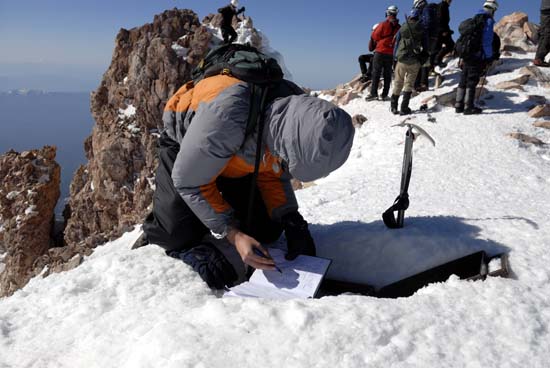 Here you see a climber signing the summit register book that is enclosed in a metal box on the top of Mt Shasta.
Entries in a summit register vary from a simple note of a person's name and date of the climb, to notes about the scenery, or even long essays about the events of the climb.
Here you see a climber signing the summit register book that is enclosed in a metal box on the top of Mt Shasta.
Entries in a summit register vary from a simple note of a person's name and date of the climb, to notes about the scenery, or even long essays about the events of the climb.Some people think that summit registers spoil the wilderness experience, but I disagree. I think they add a lot to the excitement of climbing a mountain, and many times they include invaluable history about a peak or climb. Mt Shasta is a very popular climb, and there are many entries in the book. Sometimes it is just plain fun to read some of the writings. It adds to the whole adventure.
Climbing Mt Shasta is a great adventure and most of those who put in the hard work that it takes to reach the summit count it as one of the greatest experiences of their life. Once the highest point on the mountain has been conquered, and the summit bid is complete. You will find the views are fantastic.
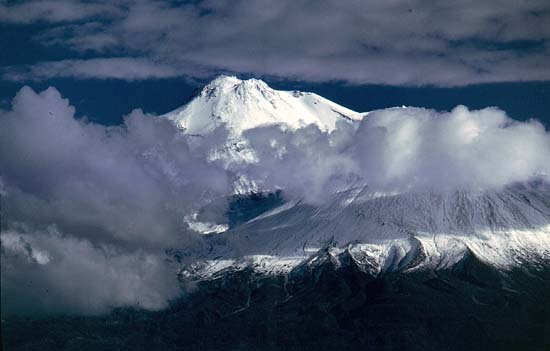 The summit is just the half way point, you still need to get back down. Mountaineering records reveal that most accidents (approx 80%) occur on the way down and not on the way up. This makes sense because of these following few facts:
The summit is just the half way point, you still need to get back down. Mountaineering records reveal that most accidents (approx 80%) occur on the way down and not on the way up. This makes sense because of these following few facts:
- Climbers/hikers are usually very tired after putting in a lot of hard work to reach a summit. And good strength and endurance are still required to descend the mountain.
- Downward momentum can work against you and hasty footing can cause a tumble before you can regain your balance. When ascending you see your up and coming foot and hand holds much better than when going down.
- Take short rest stops if necessary, and remain alert at all times. Do not take your descent for granted.
Many climbers on Mt Shasta glissade (or slide) down some parts of the mountain. Particularly between Red Banks and Lake Helen. This can certainly speed things up considerably, but care still must be taken. An ice ax is vital because without it stopping could become next to impossible.
And do not forget to take off your crampons. There have been a fair share of broken ankles due to this oversight. Also be careful when it comes to getting into well worn glissading troughs that have been previously dug out by parties sliding down the mountain. They can become very compact and icy. You can obtain some pretty incredible speeds in these chutes, but the downside is that stopping can also become problematic. I found out on my last trip that it is far better to establish your own path then to use someone else's previously formed ice chute. Often snow conditions just a few feet away from an established path are much softer. The good part about all this is that the soft snow will build up nicely in front of you as you slide. This, along with your ice ax, will make glissading much easier when it comes to controlling your speed.
Lastly, I hope that you have enjoyed your visit here at Timberline Trails, and that the account of Mt Shasta was helpful to you. For much more on Mt Shasta just click on the Shasta link in the menu above to check out some of the other links for more adventure on Mt Shasta!
Email Sign Up
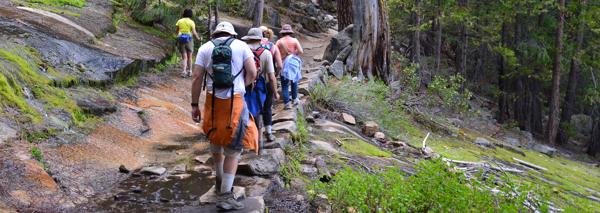
| Join the Adventure! Sign up here for Timberline Trails Monthly Newsletter |

Join us on Instagram

©2006-2024 TimberlineTrails. All Rights Reserved.
....